Final Cartridge 3
| Final Cartridge 3 | |
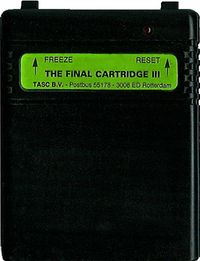 | |
| Type: | Cartridge |
| Producer: | RISKA B.V. Home & Personal Computers |
| Price: | 99 DM, ca. 50 € |
| Released: | 1987 |
| Discontinued: | 1993 |
| Processor: | |
| Memory: | |
| OS: | |
| Info: | It exists differents versions for C64/128, the last was the Final Cartridge 3. |
The "Final Cartridge 3" is a cartridge, which can be operated on the Expansion port of the C64 or the C128. It was developed in 1987 from the company RISKA B.V. Home & Personal Computers (based in: Rotterdam in the Netherlands). It provides over 60 new functions to the C64-user (e.g. BASIC-Extension, Fastloader and -saver for the 1541 with an acceleration factor of 10, Freezer, Monitor). Additionally there is a graphical user interface (Desktop) with windows (similar to GEM or Windows). From the hardware there is a Reset- and a Freezer-Function. The 1581 is not supported.
Activation resp. deactivation of the cartridge[edit | edit source]
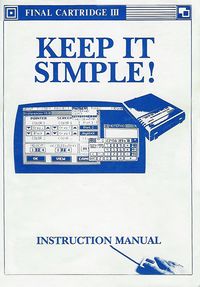
- Activation in the desktop or graphic-mode
- Power on the C64
- Reset + Press the C=
- Command
DESKTOPfrom BASIC
- Activation in the basic-mode
- Power on the C64 & press RUN/STOP
- Reset + press RUN/STOP
- Deactivation
- With the command
KILL - With the command
SYS 64738 - In the Freezer-Menu
FINAL KILL- This is the most thorough deactivation. Games which will refuse to start and where also a BASIC-KILL will not help should be treated following: Load normally, LIST, memorize SYS-Address, call freezer, FINAL KILL, then enter SYS manually.
- With the command
Functions of the "Final Cartridge 3"[edit | edit source]
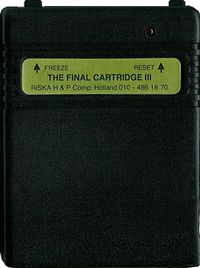
All additional functions are only usable, if the "Final Cartridge 3" is active. Apart from the Expansion port connector and the red LED, the cartridge has two push-buttons for the reset and the freezer-function.
Functions in BASIC[edit | edit source]

The function keys in BASIC are assigned as follows:
- F1 Execute of the BASIC command LIST
- F2 Calls the built in Machine Code Monitor (MONITOR)
- F3 Execute the BASIC command RUN
- F4 Restore a BASIC program after a NEW or software reset (OLD)
- F5 Load program from disc (DLOAD)
- F6 Save program to disc (DSAVE)
- F7 Show disc directory without loss of the program (DOS"$)
- F8 Send Disc command (DOS)
There are the following BASIC expansions:
- Scroll function (down and up) within a BASIC listing
- Printer-Interface, i.e. usage of Centronics printer under BASIC V2
- Hardcopy with the key combination CTRL +RETURN
- 30 additional BASIC-commands (* Commands have been expanded):
- APPEND, ARRAY, AUTO, BAR, DAPPEND, DEL, DESKTOP, DLOAD, DOS", DOS"$, DSAVE, DUMP, DVERIFY, FIND, HELP, KILL, LIST *, MEM, MON, MREAD, MWRITE, OLD, OPEN *, ORDER, PACK, PDIR, PLIST, RENUM, TRACE, TYPE, UNPACK
The cartridge prevents changing the Interrupt vector in BASIC direct mode. Due to this, many utilities that hook into the interrupt will not work.
Graphic User Interface (Desktop)[edit | edit source]

The desktop contains menus with windows and a pointer which can be moved in 3 different ways:
- Joystick: both control ports possible
- Keyboard: <F1>,<F3>,<F5>,<F7> for the directions and <C=> to select.
- Mouse: Attention - With the old Version of the "Final Cartridge 3", only in joystick mode (press right mouse key on the mouse 1351 during power on!).
In the desktop there are the following menus:
- INFO
- DESKTOP: Display the authors and developers of the "Final Cartridge 3"
- VERSION: Display the manufacturing date and Version number of the "Final Cartridge 3"
- SYSTEM
- BASIC: Terminates the desktop and switched to the usual C64-screen.
- FINAL KILL: Switches off the "Final Cartridge 3".
- FREEZER: Activates the freezer
- REDRAW: Refresh screen
- PROJECT
- NOTEPAD: Call the notebook (internal text processor)
- DLINK: Reserved for future Expansions for disk operation
- TLINK: Reserved for future Expansions for tape operation
- UTILITIES
- PREFERENCES: Settings like screen color, pointer color, pointer speed or joystick control.
- BASIC PREFERENCES:
- KEYBOARD CLICK (De-/activates a key beep)
- KEY-REPEAT (De-/activates key repeat)
- CURSOR-BLINK (De-/activates the blinking of the cursor)
- DEFAULT DEVICE (Define the device address for loading and storing; 1=datasette, 8 or 9 disc drive)
- BORDER COLOR (changes border color), NUMERIC KEYPAD (De-/activates the numeric keypad of the C128 in the C64 mode)
- CALCULATOR: Starts a simple pocket calculator
- DISK: Calls some disc functions like directory
- DIRECTORY (max. 3 can be displayed simultaneously)
- Depending on the version of the FC3 "DIR" supports also sorting of the disc directory
- RUN (load and start a selected program)
- VALIDATE (validation)
- SCRATCH (delete file)
- INITALIZE (initialize disc)
- FAST FORMAT (format disc)
- EMPTY (delete disc)
- RENAME (rename file)
- CHANGE DISKNAME (change the name of the disk)
- READ STATUS (show error status of the disk drive)
- DIRECTORY (max. 3 can be displayed simultaneously)
- TAPE: Call the tape functions SLOW (load a program) and FAST (fast loader, i.e. 10 times faster as the standard load routine).
- CLOCK:
- TIME: Display time in the menu bar
- ALARM: Toggle the alarm function.
- SETTINGS: Set the digital clock (actual time and alarm)
Freezer[edit | edit source]

With the freezer-function you can freeze running programs and save the memory content to Diskette or Datasette. This serves amongst others to create personal backups or to print out screens (hardcopies) in b/w or color.
The following menu items exist:
- BACKUP
- Disk (Copy to disc)
- Tape (Copy to tape)
- FDISK (Fast copy to disc)
- FTAPE (Fast copy to tape)
- GAME
- Sprite 1 (Disables sprite to sprite collision detection)
- Sprite 2 (Disables sprite to background detection)
- Joyswap (Switches the joystick ports)
- Autofire (Enables autofire on joysticks)
- COLORS
- BackGnd (change backgroundcolor)
- ForeGnd (change character color)
- Border (change border color)
- PRINT
- Settings (Printer settings)
- View (Print preview, colors can be modified as well)
- PSet (Change of the print resolution)
- RESET
- Kill ("Final Cartdrige 3" will be deactivated)
- Zero Fill (Reset with erasing the memory)
- CBM 64 (The C64 will be restarted)
- EXIT (terminates the freezer)
- Run (Program will be continued)
- Monitor (Calls the monitor program)
- Desktop (Return to the GUI of "Final Cartridge 3")
Monitor Program[edit | edit source]
One of the features of the "Final Cartridge 3" is a monitor, which can be used as assembler-, disc-, character- and sprite-monitor. Within the monitor, only the function keys <F3>, <F5> and <F7> can be used. It provides the following functions:
- .A Assemble
- .C Compare
- .D Disassemble
- .EC Output data as character
- .ES Output data as sprite
- .F Fill the memory
- .G Start a binary program
- .H Hunt memory (search)
- .I Input of text
- .L Loading a binary program
- .M Memory dump
- .O Switch between RAM and ROM
- .OD Start the disc monitor
- .P Activate the printer output
- .R Register view
- .S Save a memory area
- .T Transport a memory area within the RAM
- .X Terminate monitor
- .# Decimal to Hexadecimal
- .$ Hexadecimal to Decimal
- .@ Send disc command (like DOS")
- .*R Disk monitor command: Read a sector
- .*W Disk monitor command: Write a sector
The Hardware[edit | edit source]
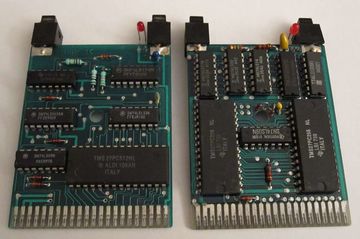
The hardware of the FC3 has several functions. First, it should enable the access to the 64k ROM. There exists a register at the address $DFFF in the IO2-Area of the C64, which enables it to control mapping 16k or 8k areas of the ROMs to the C64 memory. Second it enables it to select 16k banks from the 64k FC3-ROM.
To provide these functions, in this register are bits to control the status of the lines GAME and EXROM of the C64, the address lines A15 and A14 of the EPROMs and the LED of the cartridge.
Structure of the banking register:
Bits:
0 - A14
1 - A15
2 - unused
3 - unused
4 - EXROM
5 - GAME
6 - unused
7 - Freeze Mode (LED control)
A14 and A15 can be read out indirect via $DE00. Although there is no register, the FC3-ROM contains at this address the value, which would be under normal conditions at the address $DFFF-register.
There are two different versions of the hardware known to exist. One with two 27256 EPROMs and few extra logic, and another one with a 27512 EPROM and several TTL-chips. To which extent these are functionally different is not known. However, the register at $DFFF seems to be identical.
The TTL-chips of the 27512 EPROM version: 74LS09, 74LS14, 74LS133, 74LS174, 74LS163.
The TTL-chips of the 2x27256 EPROM version: 74LS00, 74LS09, 74LS14, 74LS133, 74LS174, 74LS163.
Compatibility to newer hardware like SD2IEC[edit | edit source]
One good thing more of the FC3 and its Fastloader is, that it is compatible to the SD2IEC and some of its Filebrowsers, like for example CBM-Browser or SD2BRWSE. This means, the FC3-Fastloader stays alive in this browsers and loads all software faster. All singlefile prg-files works with it and also about 90% of the m2i-files. If a game does not like the FC3-fastload, then you can simply load the first file with fastloader and then type "kill" in the Basicscreen. Now FC3 is deactivated and the rest of the loading works normal. Also the F-key shortcuts of the FC3 and his simplified CBM-DOS-commands makes working with a SD2IEC much easier. The Final-Cartridge-3 and the SD2IEC build a very good and comfortable combination.
Clones[edit | edit source]
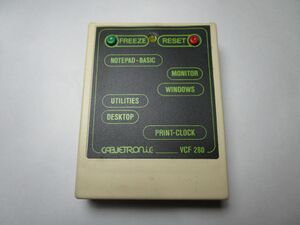
In 1990 an Italian factory called CABLETRONIC introduced a clone of FC3 cartridge, named VCF 280, where "V.C.F." means "Velocizzatore-Copiatore-Freezer" (Speed increaser-Copier-Freezer).
It was produced for a short while, sold only in Italy, and is not certain if it was officially licensed by Riska or an illegal copy.

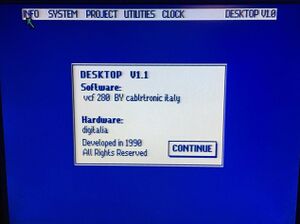
The VCF 280 electronic diagram is an exact copy of the FC3 "new" (with 27C512 EPROM), and even PCB layout is very close to original (but for the 2 bottons that are placed on top side, instead of rear).
The VCF 280 firmware, labelled "Desktop V1.1", is in fact the original Riska "Desktop V1.0" with some titles and flags translated into Italian.
Trivia:
_ In the credits page of VCF 280 cartridge there's a typing mistake, and the manufacturer name is shown as "CABLRTRONIC".
_ Nowadays no futhers info are available about the Cabletronic society, and even in the original user's manual of the VCF 280, is never shown the entire business name either an address or another way to contact the manufacturer.
Links[edit | edit source]
| Wikipedia: Final_Cartridge |